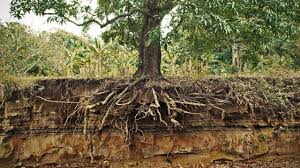Types and Usage
In vascular plants, the root is the organ of a plant that typically lies below the surface of the soil. Roots can also be aerial or aerating, that is, growing up above the ground or especially above water. Furthermore, a stem normally occurring below ground is not exceptional either (see rhizome). Therefore, the root is best defined as the non-leaf, non-nodes bearing parts of the plant’s body. However, important internal structural differences between stems and roots exist.
A true root system consists of a primary root and secondary roots (or lateral roots).
Types and Usage of Roots:
1. Adventitious: Roots arise out-of-sequence from the more usual root formation of branches of a primary root, and instead originate from the stem, branches, leaves, or old woody roots.
2. Aerating: Roots rising above the ground, especially above water such as in some mangrove genera (Avicennia, Sonneratia).
3. Aerial: Roots entirely above the ground, such as in ivy (Hedera) or in epiphytic orchids. Many aerial roots, are used to receive water and nutrient intake directly from the air – from fog, dew or humidity in the air.
4. Contractile: these pull bulbs or corms of monocots, such as hyacinth and lily, and some taproots, such as dandelion, deeper in the soil through expanding radially and contracting longitudinally. They have a wrinkled surface.
5. Coarse: Roots that have undergone secondary thickening and have a woody structure. These roots have some ability to absorb water and nutrients, but their main function is transport and to provide a structure to connect the smaller diameter, fine roots to the rest of the plant.
6. Dimorphic: Roots with two distinctive forms for two separate functions
Fine roots: typically primary roots <2 mm diameter that have the function of water and nutrient uptake. They are often heavily branched and support mycorrhizas. These roots may be short lived, but are replaced by the plant in an ongoing process of root ‘turnover’.
7. Haustorial: Roots of parasitic plants that can absorb water and nutrients from another plant, such as in mistletoe (Viscum album) and dodder.
Propagative: Roots that form adventitious buds that develop into above ground shoots, termed suckers, which form new plants, as in Canada thistle, cherry and many others.
8. Proteoid or cluster: dense clusters of rootlets of limited growth that develop under low phosphate or low iron conditions in Proteaceae and some plants from the following families Betulaceae, Casuarinaceae, Elaeagnaceae, Moraceae, Fabaceae and Myricaceae.
9. Stilt: these are adventitious support roots, common among mangroves. They grow down from lateral branches, branching in the soil.
10. Storage: these roots are modified for storage of food or water, such as carrots and beets. They include some taproots and tuberous roots.
11. Structural: large roots that have undergone considerable secondary thickening and provide mechanical support to woody plants and trees.
12. Surface: these proliferate close below the soil surface, exploiting water and easily available nutrients.
13. Tuberous: fleshy and enlarged lateral roots for food or water storage, e.g. sweet potato. A type of storage root distinct from taproot.











